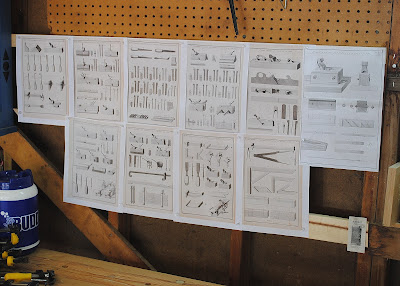Roubo's Tool Chest: Marking & Measuring
Sometime around the end of May I printed out these plates from Andre Roubo's "l'Art Du Menuisier" and tacked them to my shop wall over my workbench. Ten pages of planes, marking gauges, chisels, clamps and more. I will admit when I put them up I had no real plan. I was fascinated with the moulding planes, but mostly I just though this should be something I take a look at every day.
Time hasn't passed without effect.
It started with this little vignette on Plate 15. I like making wooden squares even though I have more than enough I find myself working on a small run of them every 18 months or so. Making them is my version of doing a Gottshall Block. As I looked on I decided I had never made a miter square before so maybe it was time.
I started with a chunk of 1 1/4" square walnut and a slice of cherry 1/4" thick by around 5" wide.
I plowed a 1/4" groove in the walnut to accept the cherry blade and even though the representation in the book is plain, I had been watching a bunch of Melencolia Squares fly around the internet for a while and decided to make a little moulding to the other side of the walnut. The moulding turned out with mixed results in the end.
After gluing them up and truing them up I hit them with the polisoir, beeswax, and a couple coats of garnet shellac.
Since I was in the process I figured I'd make the bevel gauge too. The best detail about this little beast wasn't evident to me until I was looking close at the high resolution images in Lost Art Press's "Book Of Plates"
There is a nice little Cyma cutout on the end of the blade and the fence, but in the high-res you can clearly see a dotted line showing the blade, when closed, is supposed to mate up with a perfectly cut out Cyma landing spot. Blew my mind a little bit with this detail.
I took one piece of walnut and ripped it into three thinner strips at the bandsaw. Then I cut the moulding into the blade/center piece, and glued the solid end back together
Locating the pivot pin perfectly is a challenge but the bevel works fine with a small amount of error and the walnut looks great.
I have finished one more piece from Roubo's Tool Box recently and if you follow me on Instagram, Facebook, or Twitter you already know the results, but it will have to wait a few days here. The question is, if you have an itch what do you do?
Ratione et Passionis
Oldwolf













Derek
ReplyDeleteRoubo continues t amaze me as to its wealth of treasures. I too have been captivated by -- and replicated many -- the tools he describes and illustrates. Regardless of how many times I browse it, and believe me over the past decade it has been more times than I can recount, something new pops up. For example, I was looking for something else recently and found myself in the section on building carriages and noticed again the amazing but different version of his workbench. I'll be blogging about that soon. Thanks for your recitation of replicating his tools.